Last Updated on 03/28/2021 by Desmond
Wuyi Rock teas play an essential part in Oolong, and they are famous for their unique “Yan Yun“(rock flavor.) From the description we see, this flavor is very impactful. But among them, a type named Bai Jiguan tea is totally different, either the looks and the taste. Imagine if the other Wuyi Rock teas are the strong warrior monk, then Bai Jiguan tea is just like a tender nun.
CONTENT
What Is Bai Jiguan Tea
Bai Jiguan tea is also called white cockscomb tea, one of the Wuyi 4 great Ming Cong(famous tea trees.) Buddhism is popular in China, and many teas are also named according to the Buddhism figure, such as Tieguanyin, Tieluohan. But actually, Taoism is the true native religion of China. And Bai Jiguan tea is the only one regarded as a Taoist Tea.
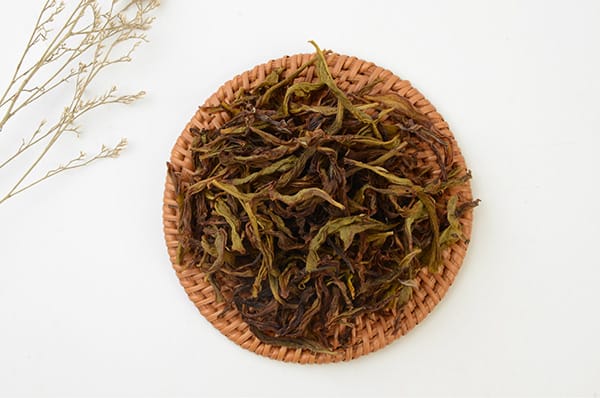
Names Legends
Just like the other teas, about Bai Jiguan tea’s name, there is a mythological.
It is said in Ming Dynasty. A monk heard some noise outside after he finished a meditation. He out and check and found that an eagle was attacking some chicken. A hen was fighting with the eagle to protect her chicken, and she finally dies.
The monk was moved and burry the hen’s body under a tea tree around. A year passed, the monk found that the tea tree was growing different; its leaves are white and rise like a cockscomb, shining bright under the sun. He picks the leaves and makes them into tea, and the flavor was awesome! To remember the hen, he named the tea Bai Jiguan(White Cockscomb.)
A more credible saying is, there is no myth story, this name all because of its tea trees look. Its leaves develop above the syncline, show yellow and grass. The newborn buds are lighter, close to white, and with fuzz. Leaves and buds stacked, looks like a white cockscomb from a distance.
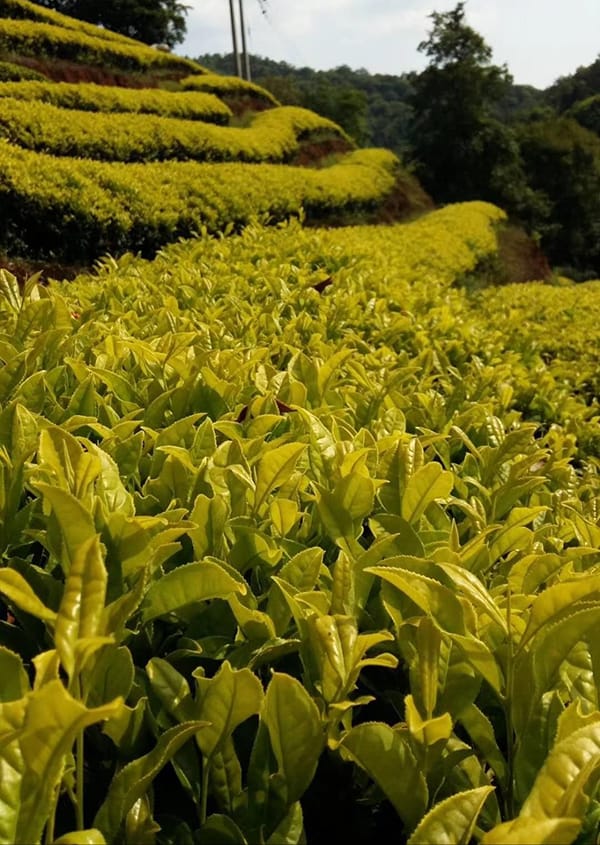
The reason why calling Bai Jiguan tea as Taoist Tea is about a legend. It is said that the tea was developed by Bai Yuchan, a leader of Taoism. He did meditation practice in Wuyi Mountain and having Bai Jiguan tea to help coordinate breath. He finally became an immortal. The other Taoists thought the tea had a big deal with, so they all took this tea as a daily beverage and called the tea “Taoist Tea.”
Origin
Bai Jiguan tea originated in the Wuyi producing-region, Fujian; earliest be found in a bat cave in Ming. Even though it is one of the famous Oolong teas, the cultivation difficulty is hard. The seedling is also hard to survive. And it got a long growth cycle, which leads to a low yield. Tea farmers prefer to cultivate the plant which with a higher ROI, such as Da Hong Pao, Shui Xian, and Rougui. So Bai Jiguan tea is rare, the total yield in the Wuyi region is only several hundred kilograms, and the price is high.
Tea Tree Type (With Leaf Albinism )
As one of the Wuyi 4 Great Tea Trees, Bai Jiguan is significantly different from the others. When you step into the Wuyi tea plantation, maybe you can not distinguish between Da Hong Pao, Shui Xian, and Rougui; but you are sure to recognize the Bai Jiguan tea tree at once. The leaves of the others are almost deep green, and Bai Jiguan’s is yellow. It is all because it suffers from a gene variation – Leaf Albinism.
Albinism is a common gene variation in plants and animals; the most we know about is the white tiger. Except for Bai Jiguan, Anji White Tea is also from a leaf albinism tea tree.
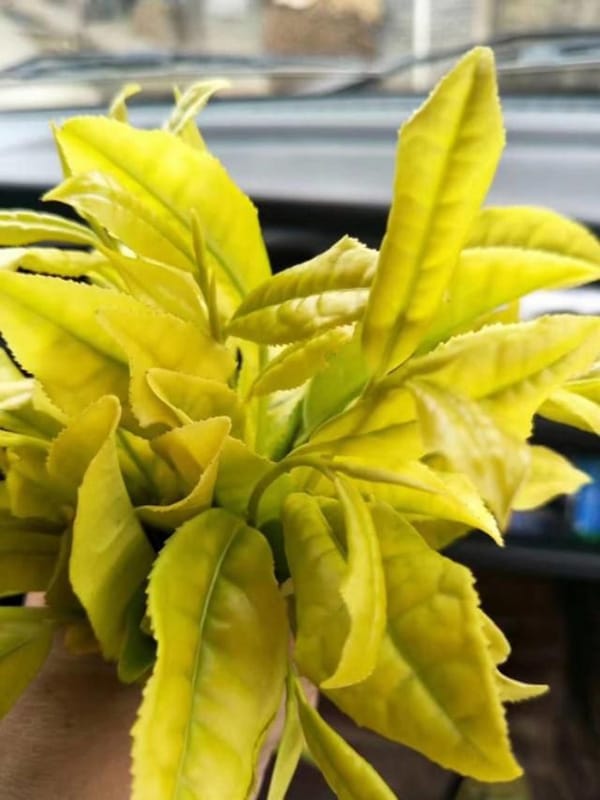
Researchers reported in 2016 that they got a conclusion according to an experiment: the Leaf Albinism on the Bai Jiguan Tea tree is related to the sunlight. The relevant genes for controlling photosynthesis will be suppressed expression under the sunshine. It affects chlorophylls and Carotenoids’ synthesis, making the leaf turn a lighter color(not totally white.) The newborn buds show a light-yellow close to white and turn yellow by growing; if without sunshine, the leaves will turn back to a regular green.
Bai Jiguan belongs to the clonal small arbor, middle-leaf Camellia Sinensis. It got a luxuriant tree-crown, leaves with less fuzz, and the sawteeth on the rim are shallow. Due to the albinism reason, it contains less tea polyphenol, which’s about 28.2%. The caffeine content is about 2.9%. By contrast, it got much more amino acid than other teas, which’s about 3.5%. So Bai Jiguan tea tastes much fresher.
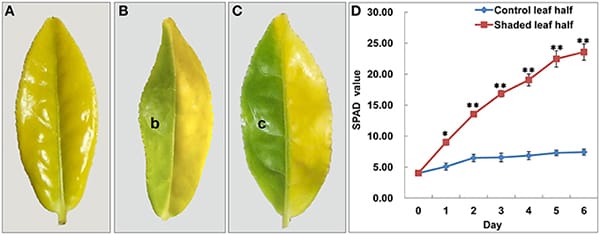
Bai Jiguan Tea Processing
Bai Jiguan tea typically starts to be harvested from the middle of May; the picking standard is one bud and to the second or the third leaf. Then the leaves will be placing, sunning, shaking, frying, rolling, and roast drying to make into tea. Some steps will be repeated multiple, like shaking, rolling, and roasting.
Not only to cultivate is challenging but also the processing too. Maybe due to the albinism, Bai Jiguan’s leaves are fragile. In Oolong tea processing, shaking is an important step. Tea masters need to put the leaves on a giant bamboo sieve and shaking them again and again. Thus, the rims are broken, the juice flows out and covers the body, make the rim and the body got a different fermentation degree. And it also makes a unique feature of Oolong tea – red rim and green body.
The fragile body of Bai Jiguan easily breaks too much during shaking. It not only leads to an over-fermentation but also affects the looks. The same situation in rolling and drying; it needs a gentle operation. Thus, during Bai Jiguan tea processing, these 3 steps will be repeated multiple, and cost more time. If the fermentation and roasting are too over, it affects the tea flavor a lot.
How Does Bai Jiguan Tea Taste Like?
Bai Jiguan tea also has a large different flavor from other Wuyi rock teas. The others most are strong at floral and fruity, and with the so-called “Yan Yun”(rock flavor.) Bai Jiguan tea is with a robust herb scent. It’s different from the strengthful TCM scent of Tieluohan tea; the aroma of Bai Jiguan is gentler, like the houttuynia and honeysuckle.
Because the source leaves are yellow and the processing is gentle, the Bai Jiguan shows a lighter color than other rock teas after making it into dry leaves. Their bodies are tight, show tawny; you can see the rim – the part with a deeper fermentation clearly. Be close and take a smell, there is a fresh, delicate, and mild aroma. If you close your eyes, you may misconceive it as a kind of herbal teas.
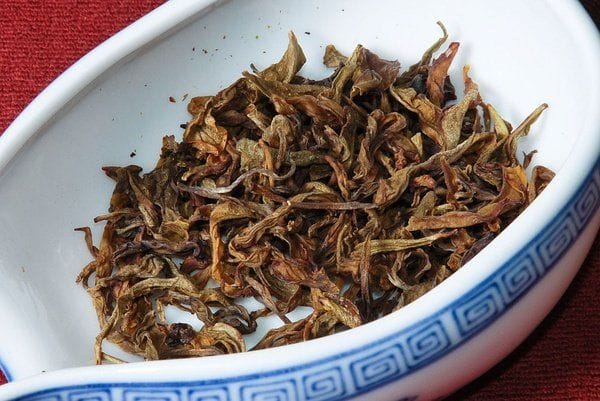
After you make it into an orange-color infusion, the leaves will be fully expanded, and the red rim becomes more obvious. Have a sip, a plant scent comes to your oral, with a little bit bitter and astringency, but not as strong as black tea. The rich amino acid also brings a fresh mouthfeel. Let it slid down your throat, a slight sweetness and cool feeling will appear on your tongue root, and the aroma also lasts a long time.
Maybe due to the albinism plant’s unique feature and the caffeine effects, you will feel your blood flow boosts quickly, even sweat, as relaxed as enjoying a massage—no wonder the Taoists take Bai Jiguan tea as a daily drink for better detox and meditation.
Storage Ways
We’ve talked before, the Bai Jiguan leaves are fragile, which need to be processed gently. After they are dried, they become more fragile because of roasting. Even though the product has a separate sealed package, you also need to be gentle when moving it or find it all broken after opening the package. And to the loose-leaf, they will easily absorb the water in the air, get a damp smell, or even mold.
Most of the teas need a dark environment during storage. Bai Jiguan tea requires higher; it got more sensitive to the sunlight because of the albinism genes. The part with a lower fermentation may change flavor in a short time by the sunniness. Besides, the requirement on temperature also high, which needs to be relatively cold. Bai Jiguan tea got a short shelf life and not suitable for aging; it’s better to finish consumed in half a year.
During Bai Jiguan tea storage, pay attention to the following:
- Dry
- Dark
- Low-temperature (lower than 20℃)
- low oxygen environment
A recommended method is: if it got separate sealed packages, put them into an iron can with desiccant, then store them in a fridge. If it is loose-leaf tea, pack it well with rice paper, then put it in a clay can, and store it in a dark, dry, cool place but not a fridge.
How To Make Bai Jiguan Tea
- Prepare and pre-heat the teawares. A 120ml porcelain Gaiwan seems to be excellent;
- Put 10g leaves in, add hot water, cover, then pour out the wastewater soon. Pay attention, when adding water, pour it at low, to avoid the violent flow breaks the leaves;
- Refill 95℃ water, cover, steep for about 10-20 seconds;
- Pour the infusion in a fair cup to equal the concentration;
- Serving;
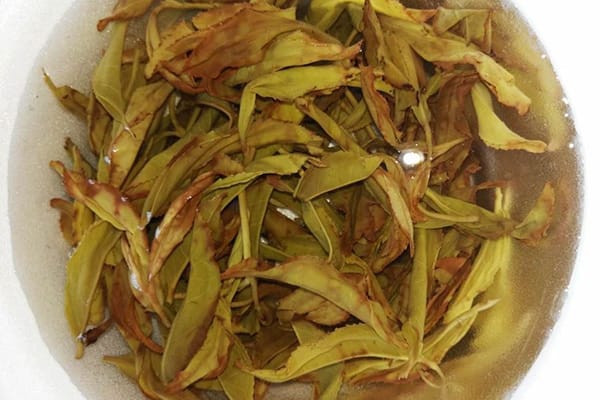
Even though Bai Jiguan’s flavor is largely different from other rock teas, it still got the characteristic of resistance to brewing. Typically, it can be brewed over 7 times, some high-quality products even over 10. After the third brew, you can extend 5-10 seconds steeping time every following according to the infusion concentration.